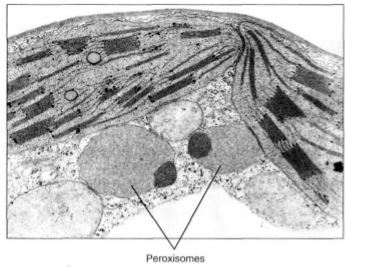


 النبات
النبات
 الحيوان
الحيوان
 الأحياء المجهرية
الأحياء المجهرية
 علم الأمراض
علم الأمراض
 التقانة الإحيائية
التقانة الإحيائية
 التقنية الحيوية المكروبية
التقنية الحيوية المكروبية
 التقنية الحياتية النانوية
التقنية الحياتية النانوية
 علم الأجنة
علم الأجنة
 الأحياء الجزيئي
الأحياء الجزيئي
 علم وظائف الأعضاء
علم وظائف الأعضاء
 الغدد
الغدد
 المضادات الحيوية
المضادات الحيوية|
Read More
Date: 19-10-2016
Date: 18-10-2016
Date: 16-10-2016
|
Microbodies
Viewed by electron microscopy cells are seen to contain numerous small, spherical bodies about 0.5 to 1.5 pm in diameter (Fig). These are so nondescript that it is not easy to tell exactly what they are: ER vesicles, dictyosome vesicles, or distinct organelles. However, by using special chemical reactions and stains, it has been possible to determine the contents and even the types of reactions in these bodies.

FIGURE : Electron micrograph showing two chloroplasts with two peroxisome-type microbodies next to them. In many plants, photosynthesis is accompanied by a process called photorespiration, in which peroxisomes produce the amino acid glycine (approx. X 66,000). (BPS)
Some are organelles now called microbodies and there are two classes: peroxisomes and glyoxysomes. Both types isolate reactions that either produce or use the dangerous compound peroxide, H2O2.
If peroxide were to escape through the microbody membrane, it would damage almost anything it encountered. However, both types of microbody contain the enzyme catalase, which de-toxifies peroxide by converting it to water and oxygen.
Peroxisomes are involved in detoxifying certain by-products of photosynthesis and are found closely associated with chloroplasts. Glyoxysomes, which occur only in plants, are involved in converting stored fats into sugars. They are important during the germination of fat-rich, oily seeds such as peanut, sunflower, and coconut. All of the above, except ribosomes, are organelles composed of membranes; the following are non-membranous organelles.



|
|
|
|
دراسة تحدد أفضل 4 وجبات صحية.. وأخطرها
|
|
|
|
|
|
|
جامعة الكفيل تحتفي بذكرى ولادة الإمام محمد الجواد (عليه السلام)
|
|
|